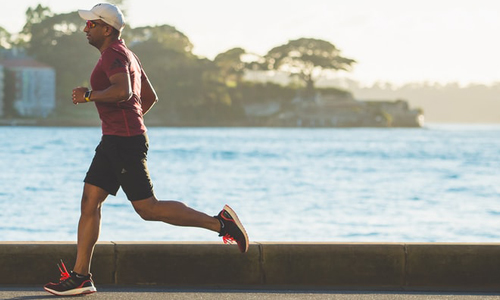Tips to Choose the Right Trail Running Footwear
Author

Mike has a real passion for cycling, hiking and just generally being outdoors. Being from Warrington, he is only a few hours away from North Wales, The Peak District, Yorkshire and the Lake District. He has climbed Mount Kilimanjaro and done a lot of the mountains in the Lake District. His new passion is walking his dog and enjoying a pint at the end.
If you are into trail running and/or are a regular runner, you might need one essential item to keep you going: trail running shoes. There are various ways to know which one might suit you best. Before that, it is important to know what trail running is.
Trail running, also known as off-the-road running, is practiced on routes which are not made of tarmac or concrete. These include various types of terrain and surfaces, which require a good pair of shoes to hike or run.
Trail running shoes are designed to ensure your safety by maintaining a high-quality grip on different terrains including muddy, wet rock surfaces. These shoes usually have robust uppers, which provide durability when used over off-road terrain. A highly abrasion-resistant shoe, the trail running shoes have waterproof liner, such as gore-tex, which provide better protection against wet and mud puddles. You can choose the one with greater cushioning or less cushioning according to your need.

Here are a few tips to choose the right trail running footwear for your next trail running session:
Shoe drop
A shoe drop is the difference between the height of your heels and the fare-foot while wearing the shoe. Flat foot would be a zero drop. From there, the drop depth can rise to 10 mm or even more. There are various types of trail running shoes that provide different specifications according to the requirements.
Having a better shoe drop allows better engagement of the full dole on the ground. It also provides better flexibility for improved traction. While running on harder packed trails, it is better to have your heels raised a little to ensure more resilience.
The uppers
Made of robust materials, trail running shoes have a rand, which joins the sole to the upper. It helps provide protection against abrasion and to easily move through obstacles such as stones, rocks, etc.
There are various brands that are designed to be more or less robust according to their use and material design. It is, therefore, advisable to check upon your wearability during the course of running. If you want waterproof shoes, you can look for Gore-Tex lining, which provides warmth during winters.
Go for darker coloured uppers as they tend to get dirty over time. It would help you save a lot of maintenance and these shoes can be used for a longer period of time.
Look at the fit, not how it looks
There are many brands that promote good fit, but aren’t chosen due to the way they look. It is recommended that you choose trail running shoes according to the fit and not based on how they look. It is very likely for brands to change their look from season to season. Therefore, it is beneficial to look for comfort and wearability.
You can go to your local sports store or a shop to try on a range of different shoes before knowing what works best for your feet. You can weigh their pros and cons and then decide. If you ever come across a good pair of trail running shoes, you can keep a stock of them for later use.

Weight of the shoes
Many runners prefer a lighter weight shoe. However, it is best to know that there are many shoes which are lightweight, and are made of fabrics that have been reduced, or the materials are compromised.
For shorter running trails, it is a good option to have a pair of lightweight shoes. There are many shoes which are mid-weight but tend to last longer.
Which pair of shoes is right for you?
You may want to think of a number of aspects before buying trail running shoes. Think of the fit, the way your heel feels, as well as comfort. Look for specific male and female fits which might make you feel comfortable. Consider the sole and the type of route in which you would be running. Look out for these aspects and find your favourite trail running shoe.
Author

Mike has a real passion for cycling, hiking and just generally being outdoors. Being from Warrington, he is only a few hours away from North Wales, The Peak District, Yorkshire and the Lake District. He has climbed Mount Kilimanjaro and done a lot of the mountains in the Lake District. His new passion is walking his dog and enjoying a pint at the end.
Categories
- Sport (28)
- Product Reviews (3)
- Team Outdoor Look (7)
- Mike Wild (2)
- Mike Payton (2)
- Suse Hammond-Pears (3)
- Snowboarding (12)
- Latest Offers (105)
- Shop Talk (1)
- Competitions (7)
- Walking (413)
- Lifestyle Fashion (8)
- Travel (86)
- Kit Guides (176)
- Workwear Clothing (6)
- Safety Workwear (4)
- Health/Fitness (289)
- Skiing (91)
- Great Outdoors (1316)
- Cycling (92)
- January 2025
- December 2024
- November 2024
- October 2024
- September 2024
- August 2024
- July 2024
- June 2024
- May 2024
- April 2024
- March 2024
- February 2024
- January 2024
- December 2023
- November 2023
- October 2023
- September 2023
- August 2023
- July 2023
- June 2023
- May 2023
- April 2023
- March 2023
- February 2023
- January 2023
- December 2022
- November 2022
- October 2022
- September 2022
- August 2022
- July 2022
- June 2022
- May 2022
- April 2022
- March 2022
- February 2022
- January 2022
- December 2021
- November 2021
- October 2021
- September 2021
- August 2021
- July 2021
- June 2021
- May 2021
- April 2021
- March 2021
- February 2021
- January 2021
- December 2020
- November 2020
- October 2020
- September 2020
- August 2020
- July 2020
- June 2020
- May 2020
- April 2020
- March 2020
- February 2020
- January 2020
- December 2019
- November 2019
- October 2019
- September 2019
- August 2019
- July 2019
- June 2019
- May 2019
- April 2019
- March 2019
- February 2019
- January 2019
- December 2018
- November 2018
- October 2018
- September 2018
- August 2018
- July 2018
- June 2018
- May 2018
- April 2018
- March 2018
- February 2018
- January 2018
- December 2017
- November 2017
- October 2017
- September 2017
- August 2017
- July 2017
- June 2017
- May 2017
- April 2017
- March 2017
- February 2017
- January 2017
- December 2016
- November 2016
- October 2016
- September 2016
- August 2016
- July 2016
- June 2016
- May 2016
- April 2016
- March 2016
- February 2016
- January 2016
- December 2015
- November 2015
- October 2015
- September 2015
- August 2015
- July 2015
- June 2015
- May 2015
- April 2015
- March 2015
- February 2015
- January 2015
- December 2014
- November 2014
- October 2014
- September 2014
- August 2014
- July 2014
- June 2014
- May 2014
- April 2014
- March 2014
- February 2014
- January 2014
- December 2013
- November 2013
- October 2013
- September 2013
- August 2013
- July 2013
- June 2013
- May 2013
- April 2013
- March 2013
- February 2013
- January 2013
- December 2012
- November 2012
- October 2012
- September 2012
- August 2012
- July 2012
- June 2012
- May 2012
- April 2012
- March 2012
- February 2012
- January 2012
- December 2011
- November 2011
- October 2011
- September 2011
- August 2011
- May 2010
- April 2010
- March 2010
- February 2010
- January 2010
- November 2009
- October 2009
- September 2009


Submit a Comment